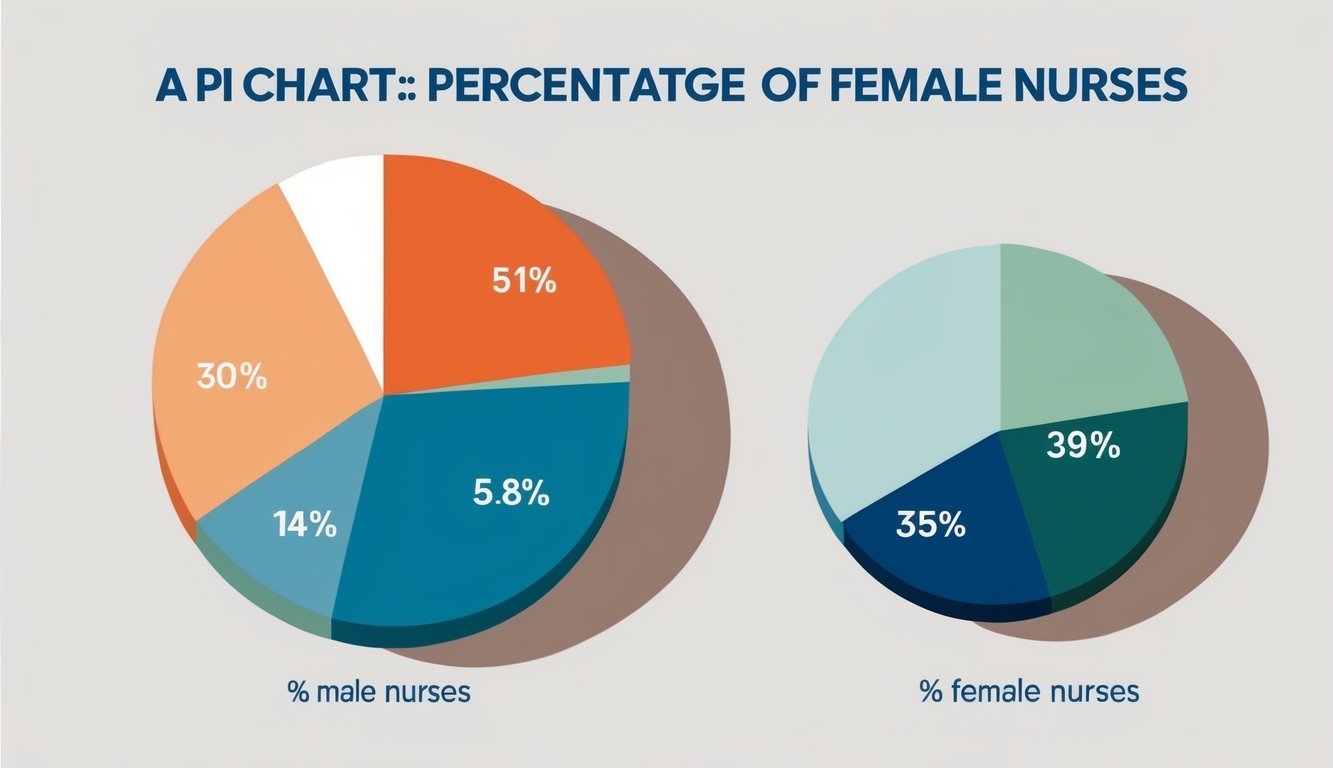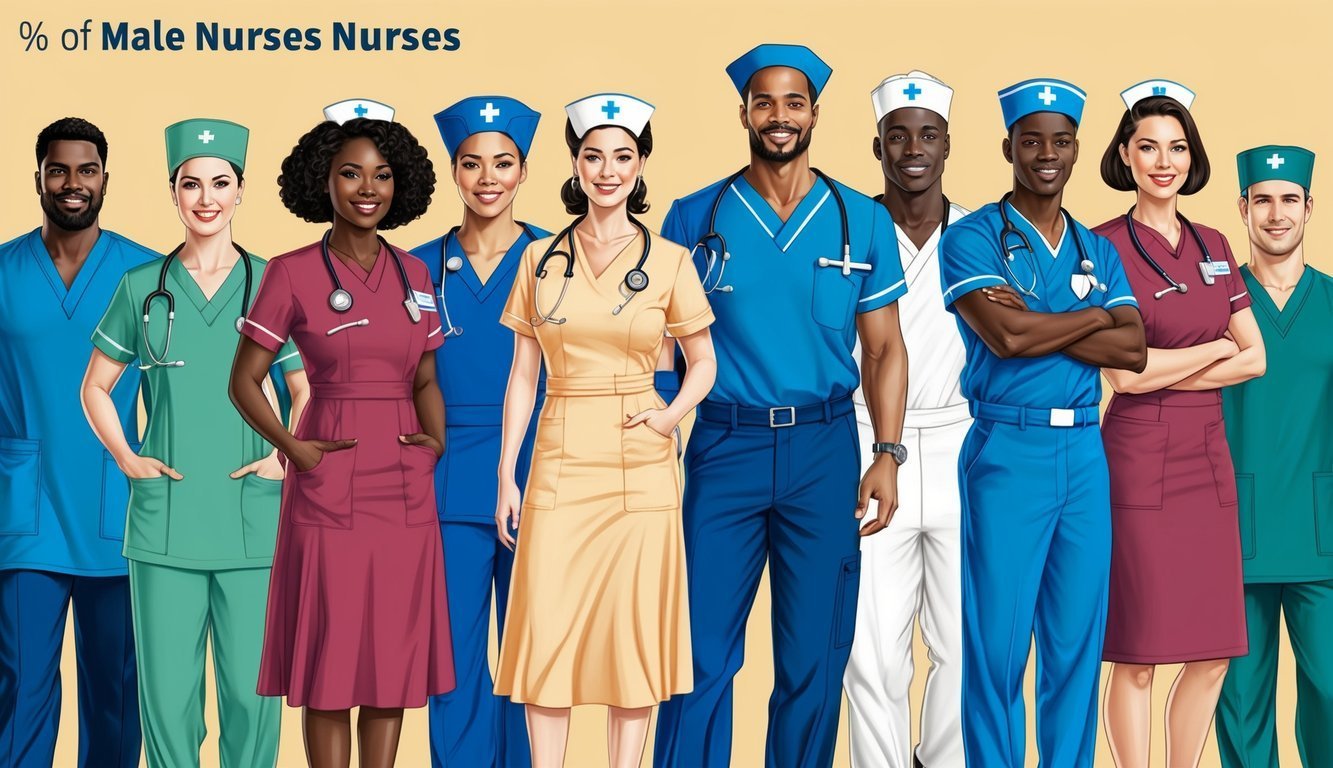Male nurses make up a smaller portion of the nursing workforce than many might think.
As of 2022, only about 12% of nurses in the U.S. are male.
This statistic highlights ongoing changes in the field, as more men are entering nursing than ever before due to shifting perceptions and increasing opportunities.
Understanding the dynamics of gender within nursing can provide insight into how healthcare is delivered.
The presence of male nurses enriches the profession by fostering diverse perspectives and improving patient care through varied experiences.
This exploration of the male nursing demographic offers a deeper look at trends, challenges, and reasons for growth in this area.
Key Takeaways
- Male nurses represent about 12% of the nursing workforce.
- Gender diversity in nursing improves patient care and outcomes.
- More men are entering nursing due to changing perceptions and opportunities.
Demographics of Nursing

Understanding the demographics of nursing helps to highlight the gender distribution and representation of male nurses across different specialties.
This section focuses on the current trends and statistics related to male nurses within the nursing workforce.
Gender Distribution in Nursing
As of recent data, approximately 12% of the nursing workforce consists of male nurses.
This number has gradually increased from 9.4% in 2020 to 11.2% by 2022.
The nursing field has historically been dominated by women, but efforts are being made to encourage more men to join.
In the United States, the total number of male nurses rose from around 303,000 in 2011 to over 500,000 in 2022.
These trends are crucial for shaping a more inclusive workforce in nursing.
| Year | Percentage of Male Nurses |
|---|---|
| 2020 | 9.4% |
| 2021 | 11.2% |
| 2022 | 12% |
Male Representation in Nursing Specialties
Male nurses are represented across various specialties, but their numbers can vary.
Some areas, like emergency medicine and critical care, typically see higher male participation compared to others, such as pediatrics or obstetrics.
For instance, around 14% of emergency room nurses are male, reflecting a trend where men may gravitate towards more demanding specialties.
In contrast, fields like maternity often have much lower representation of men.
As nursing progresses, initiatives are being launched to promote male involvement in these areas, aiming for a more balanced representation in the workforce.
Engaging men in nursing not only enriches the profession but also enhances patient care through diverse perspectives.
Nursing Education and Career Pathways

Nursing education is essential for aspiring nurses.
Understanding the various nursing programs and degrees helps you find the right path for your goals. Advanced practice registered nurses (APRNs) represent a vital role in healthcare, requiring specialized education.
Nursing Programs and Degrees
You can pursue different educational pathways in nursing.
Here are the main types of nursing programs:
| Program Type | Degree Awarded | Duration |
|---|---|---|
| Certified Nursing Assistant (CNA) | Certificate | Few weeks to 1 year |
| Licensed Practical Nurse (LPN) | Diploma | 1-2 years |
| Associate Degree in Nursing (ADN) | Associate’s Degree | 2 years |
| Bachelor of Science in Nursing (BSN) | Bachelor’s Degree | 4 years |
| Master of Science in Nursing (MSN) | Master’s Degree | 2 years |
Each program has different entry requirements and outcomes.
The ADN and BSN programs prepare you for the Registered Nurse (RN) licensure exam.
Many employers prefer nurses with a BSN.
Advanced Practice Registered Nurses
Advanced practice registered nurses (APRNs) are critical to healthcare.
They include Nurse Practitioners (NPs), Clinical Nurse Specialists (CNSs), Nurse Anesthetists (CRNAs), and Nurse Midwives (CNMs).
To become an APRN, you typically need a Master of Science in Nursing (MSN) or a Doctor of Nursing Practice (DNP).
APRNs often perform tasks such as:
- Diagnosing and treating medical conditions
- Prescribing medications
- Providing patient education
This advanced education enhances your career and opens opportunities in specialized fields.
The demand for APRNs is increasing, reflecting the growing need for healthcare services in various communities.
For more information on nursing programs, consider visiting NursingWorld.org.
Workforce Statistics and Trends

Understanding the current workforce statistics and trends in nursing reveals important insights into employment patterns and ongoing challenges.
You will find specific details about the percentage of male nurses and the factors affecting nursing shortages.
Employment Statistics for Nurses
As of recent data, the nursing workforce in the U.S. consists of nearly 4.7 million registered nurses (RNs).
Among them, the percentage of male nurses has gradually increased over the years.
In 2002, only 7% of registered nurses were male.
By 2023, this figure rose to 12%.
This growth reflects broader efforts to attract more men into the profession, addressing both staffing shortages and diversity needs within healthcare.
The nursing profession is critical in healthcare, given its size and scope.
Many men are now taking up various nursing roles and specialties to meet rising demand.
To learn more about male participation in nursing, you can check the Male Nurse Statistics report.
Trends in Nursing Shortage
The nursing shortage has become a pressing issue in healthcare.
Factors contributing to this shortage include an aging population, increasing healthcare demand, and high turnover rates among nursing staff.
According to recent reports, many healthcare facilities struggle to fill nursing positions, leading to concerns about patient care quality.
As a result, educational programs are actively recruiting more individuals to enter the nursing field.
This includes targeting men to help balance the workforce gender gap and enhance diversity.
The Health Resources and Services Administration provides further data on supply and demand challenges within the healthcare workforce, which can be found in the State of the U.S. Health Care Workforce.
The Experience of Men in Nursing
Men in nursing often face unique challenges and opportunities within the healthcare profession.
Understanding workplace dynamics and career advancement can shed light on their experiences.
Workplace Dynamics for Male Nurses
The dynamics in nursing workplaces can vary greatly for male nurses compared to their female counterparts.
While the number of male nurses is increasing, they still represent a minority in the nursing profession, accounting for approximately 12.6% of registered nurses as of 2023.
Male nurses may experience both support and resistance from colleagues and patients.
They sometimes face stereotypes questioning their compassion or professionalism.
Yet, many male nurses report that their presence can challenge these stereotypes.
They often find camaraderie and support among peers.
In some cases, male nurses may encounter unspoken expectations or biases that can affect their job security and interactions.
Nonetheless, they have opportunities to foster positive workplace environments and promote inclusivity.
Career Advancement for Men in Nursing
Career advancement for male nurses is influenced by various factors, including education and networking.
Men in nursing, like all nurses, can pursue specialized certifications and advanced degrees, leading to roles in management and education within the healthcare profession.
The growth of the healthcare field increases job security for male nurses.
With the projected RN job growth of 6% from 2022 to 2032, more opportunities for advancement are on the horizon.
Men who actively seek mentorship and engage in professional organizations can improve their chances of moving up the career ladder.
Networking can be crucial.
Joining organizations that support male nurses can connect you with other professionals and provide resources that enhance your career.
Emphasizing strong communication skills and empathy can also play a key role in your advancement in nursing.
Impact of Gender Diversity on Patient Care

Gender diversity in nursing plays a significant role in enhancing patient care.
By having a mix of male and female nurses, healthcare environments can improve patient outcomes and overall satisfaction.
This impact is especially noticeable in various nursing specialties.
Improving Patient Outcomes
Research indicates that male nurses, such as nurse anesthetists, can contribute positively to patient outcomes.
In areas like anesthesia, male nurse anesthetists often bring unique perspectives and skills.
Their involvement can lead to better pain management and recovery experiences for patients.
A diverse nursing team can lead to improved communication with patients.
For example, different gender perspectives may help in understanding patients’ concerns better.
This can enhance trust and rapport, ultimately leading to better health outcomes.
Furthermore, studies show that male nurse practitioners and midwives add value to patient care.
They can provide insights that reflect the needs of different demographics.
This can foster a more inclusive approach to treatment.
Diversity in Healthcare Settings
Diversity in healthcare settings is not just about gender but also about bringing different backgrounds together.
This blend can create a richer environment for patient care.
Male nurses often face stereotypes but also contribute to breaking down gender barriers in the profession.
Their presence helps in creating a balanced atmosphere where various viewpoints are respected.
This openness can improve collaboration among healthcare providers.
In addition, exposing patients to a diverse team encourages acceptance and understanding.
It helps patients feel more comfortable and supported, especially when they see caregivers who reflect their own experiences.
Male nurses can play a vital role in supporting this environment.
Diversity in nursing ultimately leads to enhanced quality of care and patient satisfaction.
The direct benefits are evident in the way patients engage with and respond to different nursing professionals.
Frequently Asked Questions

Male nurses make up a smaller percentage of the total nursing workforce.
You may have questions about the specifics of their roles, challenges, and how the field is evolving.
What is the ratio of male to female nurses currently in the healthcare industry?
In the nursing workforce, men represent approximately 12% of all nurses.
This means that for every male nurse, there are about seven female nurses working.
What challenges do male nurses face in a predominantly female profession?
Male nurses often deal with stereotypes that suggest nursing is a female-only profession.
They may face discrimination or feel isolated in a work environment where they are a minority.
What is the average salary difference between male nurses and their female counterparts?
Salary differences between male and female nurses are generally minimal but can exist based on factors like experience, specialization, and location.
On average, male nurses earn slightly higher salaries, but this varies widely.
What roles within the nursing field are most occupied by male nurses?
Male nurses tend to be more represented in specialized fields such as emergency medicine, critical care, and nursing administration.
These areas often require strong leadership skills, making them appealing to male nurses.
How has the presence of men in nursing changed over recent years according to workforce statistics?
From 2011 to 2022, the percentage of employed male nurses grew.
It increased from about 9.4% to around 12%, showing a gradual rise in male representation in the field.
What initiatives are in place to encourage more men to enter the nursing profession?
Various organizations promote nursing careers to men through outreach programs, scholarships, and mentorships.
These initiatives aim to break down stereotypes and showcase nursing as a viable and rewarding career for everyone.

